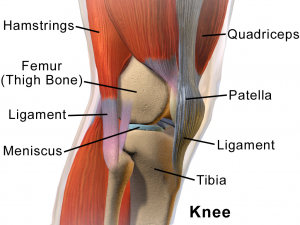 Any sort of exercise comes with physical risk regardless of whether or not the exercise itself is low impact. Cycling is no exception, even though it is considered a low impact exercise it can still hurt your knees and lead to issues if done incorrectly.
Any sort of exercise comes with physical risk regardless of whether or not the exercise itself is low impact. Cycling is no exception, even though it is considered a low impact exercise it can still hurt your knees and lead to issues if done incorrectly.
One of the key problems that many people wish to avoid cycling is knee pain, yet many people fall victim due to the repetitive motion. You have to remember that in an hour of steady cycling your knee is going in approximately 5000 revolutions, the stress may be very minimal for one revolution, but if you have muscle imbalances, or some alignment is out, by the 5000th or 10,000th stroke you may be able to feel a twinge.
How Can I Avoid Knee Problems?
A lot of people seem to think that knee pain caused by cycling spells the end for their time on the bike. Nothing could be further from the truth, in reality all you need to do is ride smart.
Too Much Too Soon
The number #1 knee pain cause – going further or harder than your ligaments, muscles or bones can handle. Being an extremist can have its downsides! Make sure to slowly build up your endurance. Your muscles and bones develop at a much faster rate than your ligaments. What will often happen is a ligament will get too tight or inflamed, especially your IT band.
So remember if you try and go too long or too hard too soon your muscles and ligaments will not be prepared for the distance or intensity and it may result in a hurt knee or worse.
Riding Long Distance
Those who ride long distances will often report lateral knee pain (outer knee pain) as the IT band continues to tighten each and every revolution.
Ideally, you should build up to long-distance cycling very slowly. Don’t expect to jump on a bike and go for miles and miles without some form of repercussion. Learn to listen to your body, know when to go hard, but more importantly, know when to take it easy.
Bike Fit
One issue that is often overlooked when people are trying to figure out why cycling is making their knees hurt is the fit of the bike itself. Riders need to pay close attention to their saddle height and angle, a saddle that is too high will cause posterior knee pain (pain behind the knee), if it is too low it will cause pain at the front of the knee. Conversely if the saddle is angled too far down then it puts undue pressure on the front of the knee as you continue to try and hold your body weight back. A saddle tilted too far back will hurt behind the knee, never mind the crotch region.
A poor bike fit can lead to a poor pedal stroke that can cause issues with a number of bones, ligaments and muscles, including the patella, or knee bone, in addition to the femur and tibia attached to it. Getting a bike professionally fit goes a long way to remedying and/or preventing problems.
Stretching and Rolling
Flexibility or lack of, is a cyclists nemesis. Eventually if you do not stretch or roll your muscles will tighten so much that you will have difficulty walking never mind riding. Make sure to do a few stretches that especially focus on loosening up the lower body.
Cycling a Form of Recovery
Cycling is actually good for knee pain! Physiotherapists tell people with knee injuries to get on a stationary bike as a form or recovery. This will stimulate blood flow to the area and allow it to heal that much more quickly.
So, is cycling truly bad for your knees? No it is not!
Suggested articles to read and videos to watch: Basic Bike Fit, Adjust Your Saddle Height, Perfect Saddle Angle, Fore and Aft Saddle Position and Ideal Cleat Position.
What About Running?
Some people may come to the conclusion that cycling isn’t for them, leading them to look into other forms of cardiovascular exercise. Running is one of the most popular, however, this can lead to even more issues.
Unlike cycling, running is a much higher impact exercise, which can lead to issues developing through repetition. In fact, the pain that many people feel around their kneecaps as a result of running is even informally known as “runner’s knee,” which demonstrates just how common the issue is.
As such, you should put a lot of thought into which exercise you wish to continue with. In many cases, any knee issues caused by cycling can be remedied through improvements in bike fit, training duration or intensity, technique or a bike fit.
Truthfully, any exercise can lead to injury as exercise by definition stresses the body. Make sure to be smart and if you feel knee pain during cycling take a break immediately and asses your situation. If you continue to have knee pain after cycling then see a physician.